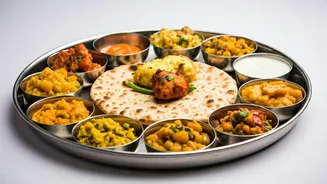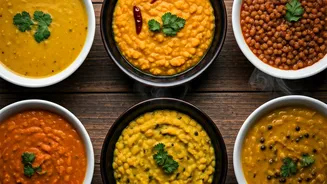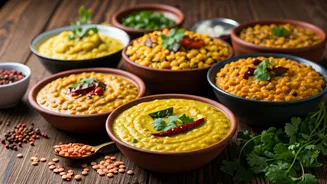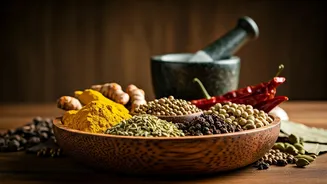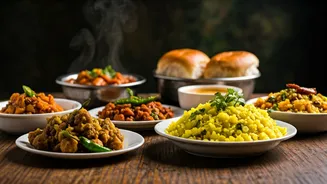Culinary Diversity of India
India's culinary scene is a vibrant mosaic, shaped by its vast geography and diverse communities. Each region presents its unique culinary identity, from
the spicy curries of the South to the rich, creamy dishes of the North. Coastal areas enjoy abundant seafood, while the interior focuses on grains, lentils, and vegetables. These regional differences are influenced by climate, local produce, and historical interactions. The Indian palate is constantly being introduced to new flavors and combinations, leading to interesting adaptations of traditional recipes. The common thread uniting these different areas is the use of spices, which not only enhance the taste but are also used for their medicinal qualities. This deep connection to spices is a defining element of the nation’s varied food culture.
Changing Eating Patterns
The eating habits of Indians have shifted in recent years, influenced by factors like urbanization, economic growth, and exposure to global food trends. The rise of nuclear families and working women has fueled the demand for convenience foods and ready-to-eat meals. Fast food and restaurant culture are gaining traction, especially in urban areas. Simultaneously, there's growing awareness of health and wellness, driving an increased interest in organic food and healthier alternatives. This dual trend reflects a transformation in how Indians approach food. Traditional home-cooked meals remain important but co-exist with a broader range of dining choices. The impact of social media and online food delivery services also plays a significant role in introducing new cuisines and influencing dining decisions. This blend creates a unique evolution within the Indian food landscape.
Vegetarianism in India
Vegetarianism is an integral part of Indian food culture, with a significant portion of the population following a vegetarian diet. This dietary practice is primarily rooted in religious beliefs, particularly Hinduism, Jainism, and Buddhism, which emphasize non-violence and compassion towards all living beings. The availability of diverse vegetarian options, from traditional dishes like dals and vegetable curries to modern adaptations, ensures a rich culinary experience. Regional variations within vegetarian cuisine provide even more choices. The influence of vegetarianism extends beyond religious practices, encompassing lifestyle choices and health considerations. This emphasis on plant-based diets has contributed to the development of unique recipes, culinary skills, and a strong sense of community around food. The availability of fresh, seasonal vegetables and fruits further supports the widespread vegetarianism, and gives a distinct character to the Indian eating style.
Impact of Globalization
Globalization has significantly transformed Indian eating habits by introducing diverse cuisines and culinary styles. The influx of international food chains, like fast-food giants, has reshaped the diets, especially of the younger population. While foreign food trends have gained popularity, Indian cuisine has also gone global, with Indian restaurants becoming commonplace in many countries. Moreover, exposure to different cultures through travel, media, and online platforms has introduced new ingredients and cooking methods. This global influence is not merely about replicating foreign tastes but also about adapting international recipes to suit local preferences. This cultural exchange has created hybrid dishes and fusion cuisines, integrating Indian spices and cooking styles with global elements. This dynamic interplay between local and global has created a richer, more diverse food culture in India.
Health and Wellness Trends
A heightened focus on health and wellness is reshaping the food choices of Indians. Growing awareness about the benefits of a balanced diet and healthy living has increased the demand for nutritious foods. This change has led to increased consumption of fresh produce, lean proteins, and whole grains. Organic and natural foods are becoming popular, as people are keen to avoid artificial ingredients and preservatives. The emphasis on home-cooked meals is also on the rise, with people preferring to prepare their food from scratch to control ingredients and maintain nutritional value. Fitness and wellness influencers are impacting this trend, promoting healthy eating habits and providing recipes for balanced meals. This growing consciousness reflects a proactive approach towards health. As people gain more understanding about the connection between food and well-being, the demand for nutrient-rich foods will only continue to rise.
Traditional Dishes Revived
There's a noticeable resurgence of interest in traditional Indian dishes, reflecting a longing for authentic flavors and a connection to cultural heritage. Many families are returning to recipes passed down through generations. This trend reflects a larger movement towards local and sustainable food practices. Traditional cooking methods, like using clay pots and slow-cooking techniques, are being revitalized as people seek to preserve the original essence of dishes. Old recipes are being reinterpreted with modern twists to appeal to contemporary tastes. This trend also involves a greater appreciation for the health benefits of traditional ingredients, such as spices and herbs. The rediscovery of regional specialties is another significant aspect. This revival of traditional cuisine contributes to maintaining the cultural identity and promoting sustainable eating habits.
Role of Technology
Technology is reshaping how Indians access and interact with food, creating new avenues for culinary exploration and consumption. Online food delivery platforms have transformed dining experiences, providing access to a wide variety of restaurants and cuisines. Digital media, like blogs, websites, and social media platforms, play an important role by showcasing recipes, food reviews, and culinary trends. Moreover, recipe apps and online cooking classes are empowering individuals to experiment with cooking at home. Technology is also supporting the growth of the food industry, with innovations in food processing, packaging, and supply chain management. This fusion of technology and food not only increases accessibility and convenience but also fosters innovation and creativity. This evolution indicates a shift towards a more digital and interconnected food environment.
